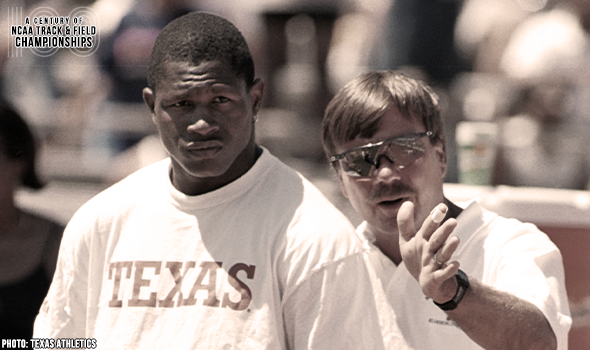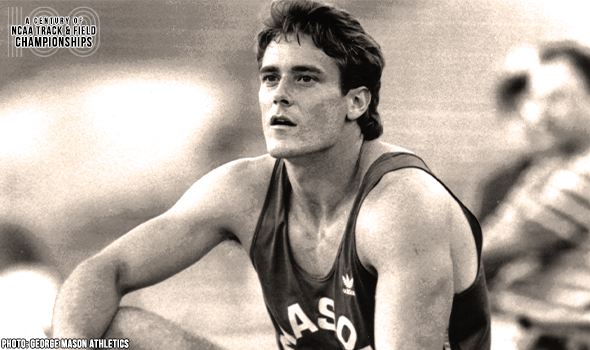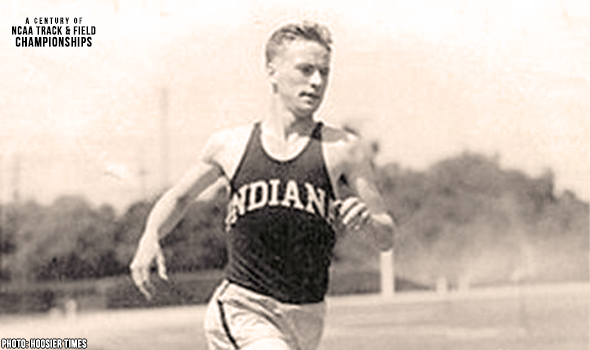
The Tie Goes To The Buckeye
Ties – and sometimes breaking them – were common for Dave Albritton of Ohio State.
But there was no breaking any of the ties in Albritton’s three-straight NCAA high jump victories, and his first in 1936 was historic as he and Buckeye teammate Mel Walker became the first Black athletes to win the event.
That duo was part of an amazing Ohio State team in 1936: They contributed two of the record seven NCAA titles the Buckeyes won that year, joined by Jesse Owens with four (100, 200, 220 hurdles and long jump), along with Charlie Beetham in the 800 meters. No program has matched that number of champions in one NCAA meet.
However, the 1936 NCAA Championships was bittersweet for the Buckeyes, whose 73 points made them the highest-scoring runner-up team in meet history (6-place scoring system). The winning squad was powerful Southern California with 103⅓ points. The bittersweet part was that just a week earlier, Ohio State tied the Trojans in a dual meet when only wins counted, 7½-7½ – the fraction coming in the high jump, where Albritton tied USC’s Delos Thurber.
Albritton’s level of tying made a major leap a month later. A week after finishing third at the AAU Championships (on a tiebreaker), Albritton clinched a spot on the Olympic team in a brand-new stadium at Randalls Island, New York, by – you guessed it – tying Cornelius Johnson of Compton Junior College – who had won the AAU meet – as both cleared a world-record 6-9¾ (2.08m). That tie was not broken.
At the Berlin Olympics, Johnson led a 1-2-3 U.S. sweep, with Albritton earning the silver medal over Thurber’s bronze on a jump-off. Johnson and Albritton thus became the first Black athletes to medal in the Olympic high jump.
In the 1937 NCAA Championships, another Buckeye was favored – but this time it was Walker after sweeping the indoor and outdoor Big Ten titles over Albritton (and setting a world indoor best of 6-9¾ as well). Albritton came through, though, tying Colorado’s Gil Cruter for the win – Thurber was third on a tiebreaker as all three cleared 6-6¼ (1.99m). Walker, a senior, finished fourth but later in the summer raised the world record to 6-10¼ (2.09m).
Albritton and Cruter returned in 1938 as the meet record – 6-7¼ (2.01m) from 1926, then the oldest on the books – was battered like never before or since. In all, six men equaled the old standard as two – Albritton and Cruter – broke it with 6-8¾ (2.05m) clearances and tied yet again as neither succeeded at attempts at a possible WR of 6-10⅜ (2.09m).
Post-collegiate success followed for Albritton, as he won five AAU national titles – the last in 1950 at age 37. Ten years after that, Albritton was elected to the Ohio House of Representatives, serving six terms and becoming the first Black person to chair a House committee in 1969.
The NCAA and collegiate track & field will mark a momentous milestone in the spring of 2021 -- the 100th anniversary of the NCAA Championships and with that, the NCAA Track & Field Championships. In June 1921, the University of Chicago hosted the first track & field championships in NCAA history.
This point can’t be emphasized enough: Not only was the event the first for NCAA track & field, but the first championships for any sport under the sponsorship of the NCAA.
To celebrate, over each of the next 365 days, the U.S. Track & Field and Cross Country Coaches Association (USTFCCCA) will celebrate moments, student-athletes, and coaches that have made a century’s worth of championships special. From humble beginnings to important historical milestones to the modern-day, collegiate track & field has evolved with the American society.
The 2021 edition of the NCAA Division I Outdoor Track & Field Championships begin with preliminary round action on May 27-29 in Jacksonville, Fla., and College Station, Texas. The championships final site and culmination of the celebration is slated for June 9-12, 2021 at the newly rebuilt Hayward Field in Eugene, Ore.

Spearmon Sprinted Past Stacked 200 Field
Wallace Spearmon Jr. won back-to-back 200m titles at the NCAA DI Outdoor T&F Championships in 2004 & 2005. He ran 19.91 (-0.7 m/s) in 2005 to beat a loaded field by 0.17 seconds.

Collegiate Record For BYU’s Andersen
Kassi Andersen set a collegiate record in the steeplechase of 9:44.95 at the 2003 NCAA DI Outdoor T&F Championships, capping a three-year streak in which BYU athletes won the event.

Hook ‘Em, Ivan: Wagner Tied Best HJ Margin
Ivan Wagner won the high jump at the 1997 NCAA Division I Outdoor T&F Championships by more than four inches to tie the largest margin of victory in meet history.

Mason’s Muzzio Starred In Decathlon
Rob Muzzio won back-to-back decathlon titles at the NCAA DI Outdoor T&F Championships in 1984 & 1985. His victory in 1985 was by 3 points, the smallest margin in meet history.

Roesler Dusted The Competition In 2014
Laura Roesler won the 800 at the 2014 NCAA Division I Outdoor T&F Championships with a negative split (61.06/60.16) & the 2nd largest margin of victory in meet history (1.70 seconds).

Fuchs Went Back-To-Back In Shot Put
Jim Fuchs won back-to-back shot put titles at the NCAA Outdoor Track & Field Championships in 1949 & 1950. He set a meet record in that first year, heaving the orb 17.10m (56-1½).

Lash Led Indiana Dominance In NCAA’s First 5K
Don Lash led a 1-2-4 finish by Indiana in the 5K at the 1936 NCAA Outdoor Track & Field Championships. It was the first time in meet history that one team had three top-4 finishers in that event.

Surprise! Brown’s Win Sent Texas A&M To Title
Kamaria Brown beat Jenna Prandini by 0.007 seconds for the 200-meter title at the 2014 NCAA Division I Outdoor Track & Field Championships. It was the smallest margin of victory in meet history.

Coleman Cruised To The Bowerman In 2017
Christian Coleman dazzled at the 2017 NCAA Division I Outdoor Track & Field Championships and set a collegiate record in the 100!

Blanford Blitzed 100H Record Book
Rhonda Blanford set an all-conditions meet record in the 100 Hurdles of 12.70 at the 1985 NCAA Division I Outdoor T&F Championships. She also won the race by 0.30 seconds!

